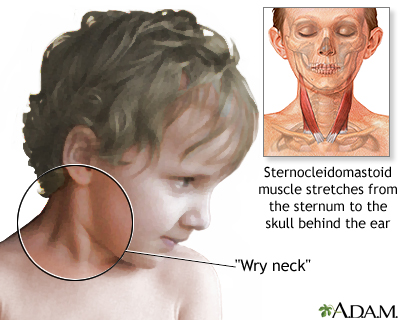Torticollis
Spasmodic torticollis; Wry neck; Loxia; Cervical dystonia; Cock-robin deformity; Twisted neck; Grisel syndrome
Torticollis is a condition in which the neck muscles cause the head to tilt, turn or rotate to the side.
Images

I Would Like to Learn About:
Causes
Torticollis may be:
- Due to changes in genes, often passed down in the family
- Due to problems in the nervous system, upper spine, or muscles
The condition may also occur without a known cause.
With torticollis present at birth, it may occur if:
- The baby's head was in the wrong position while growing in the womb
- The muscles or blood supply to the neck were injured
Symptoms
Symptoms of torticollis include:
- Limited movement of the head
- Headache
- Head tremor
- Neck pain
- Shoulder that is higher than the other
- Stiffness of the neck muscles
- Swelling of the neck muscles (possibly present at birth)
Exams and Tests
Your health care provider will perform a physical exam. The exam may show:
- The head is rotated, tilted, or leaning forward or backward. In severe cases, the entire head is pulled and turned to one side.
- Shortened or larger neck muscles.
Tests that may be done include:
- X-ray of the neck
- CT scan of the head and neck
- Electromyogram (EMG) to see which muscles are most affected
- MRI of the head and neck
- Blood tests to look for medical conditions that are linked to torticollis
Treatment
Treating torticollis that is present at birth involves stretching the shortened neck muscle. Passive stretching and positioning are used in infants and small children. In passive stretching, a device such as a strap, a person, or something else is used to hold the body part in a certain position. These treatments are often successful, especially if they are started within 3 months of birth.
Surgery to correct the neck muscle may be done in the preschool years, if other treatment methods fail.
Torticollis that is caused by damage to the nervous system, spine, or muscles is treated by finding the cause of the disorder and treating it. Depending on the cause, treatment may include:
- Physical therapy (applying heat, traction to the neck, and massage to help relieve head and neck pain).
- Stretching exercises and neck braces to help with muscle spasms.
- Taking medicines such as baclofen to reduce neck muscle contractions.
- Injecting botulinum toxin (BTX) into affected muscles.
- Trigger point injections to relieve pain at a particular point.
- Surgery of the spine might be needed when the torticollis is due to dislocated vertebrae. In some cases, surgery involves destroying some of the nerves in the neck muscles, or using brain stimulation.
Outlook (Prognosis)
The condition may be easier to treat in infants and children. If torticollis becomes chronic, numbness and tingling may develop due to pressure on the nerve roots in the neck.
Possible Complications
Complications in children may include:
- Flat head syndrome
- Deformity of the face due to lack of sternomastoid muscle movement
Complications in adults may include:
- Muscle swelling due to constant tension
- Nervous system symptoms due to pressure on nerve roots
When to Contact a Medical Professional
Contact your provider for an appointment if symptoms do not improve with treatment, or if new symptoms develop.
Torticollis that occurs after an injury or with illness may be serious. Seek medical help right away if this occurs.
Prevention
While there is no known way to prevent this condition, early treatment may prevent it from getting worse.
References
Liu RW, Glotzbecker MP. Musculoskeletal disorders in neonates. In: Martin RJ, Fanaroff AA, eds. Fanaroff and Martin's Neonatal-Perinatal Medicine. 12th ed. Philadelphia, PA: Elsevier; 2025:chap 101.
Mistovich RJ, Baldwin KD, Spiegel DA. The neck. In: Kliegman RM, St. Geme JW, Blum NJ, et al, eds. Nelson Textbook of Pediatrics. 22nd ed. Philadelphia, PA: Elsevier; 2025:chap 721.
Schroeder KM, Bouchard ML, White KK. Common neonatal orthopedic conditions. In: Gleason CA, Sawyer T, eds. Avery's Diseases of the Newborn. 11th ed. Philadelphia, PA: Elsevier; 2024:chap 89.
BACK TO TOPReview Date: 6/13/2024
Reviewed By: Joseph V. Campellone, MD, Department of Neurology, Cooper Medical School at Rowan University, Camden, NJ. Review provided by VeriMed Healthcare Network. Also reviewed by David C. Dugdale, MD, Medical Director, Brenda Conaway, Editorial Director, and the A.D.A.M. Editorial team.

Health Content Provider
06/01/2025
|
A.D.A.M., Inc. is accredited by URAC, for Health Content Provider (www.urac.org). URAC's accreditation program is an independent audit to verify that A.D.A.M. follows rigorous standards of quality and accountability. A.D.A.M. is among the first to achieve this important distinction for online health information and services. Learn more about A.D.A.M.'s editorial policy, editorial process and privacy policy. A.D.A.M. is also a founding member of Hi-Ethics. This site complied with the HONcode standard for trustworthy health information from 1995 to 2022, after which HON (Health On the Net, a not-for-profit organization that promoted transparent and reliable health information online) was discontinued. |
The information provided herein should not be used during any medical emergency or for the diagnosis or treatment of any medical condition. A licensed medical professional should be consulted for diagnosis and treatment of any and all medical conditions. Links to other sites are provided for information only -- they do not constitute endorsements of those other sites. © 1997- 2025 A.D.A.M., a business unit of Ebix, Inc. Any duplication or distribution of the information contained herein is strictly prohibited.
